Hidden Historical Gems in Makkah: A Guide for Every Pilgrim
- Home
- Makkah Ziyarat
- Historical Gems
Introduction
Masjid Al Haram
Masjid Aisha
Jannat al-Mualla
Ghar Hira
Ghar Thawr
Other Ziyarat Sites
Conclusion
This guide highlights the hidden historical gems in Makkah that every pilgrim should visit. It covers the spiritual significance of Masjid Al Haram, the Miqat of Masjid Aisha, and the resting places of the Prophet’s family in Jannat al-Mualla. The blog also explores the sacred caves of Hira and Thawr—sites of revelation and divine protection. Additional Ziyarat spots like Arafah, Muzdalifah, and Jabal-e-Rehmat further enrich the spiritual journey, offering pilgrims a deeper connection to Islamic history and heritage.
Makkah is more than just the destination for Hajj and Umrah—it is a city steeped in history, faith, and profound spiritual significance. Every street, every landmark, and every sacred site carries the echoes of the past, telling the stories of Prophets, companions, and generations of believers who have walked this holy ground. When you visit Makkah, you are not merely exploring a city; you are immersing yourself in the very essence of Islamic history and heritage.
For Muslims around the world, visiting Makkah is a lifelong aspiration. While the Kaaba remains the heart of every pilgrimage, the city is home to several other revered sites that offer deeper insights into the roots of Islam. These Ziyarat places in Makkah stand as testaments to faith, devotion, and divine intervention, each holding a unique story of sacrifice and spiritual enlightenment.
Exploring these sacred sites is an opportunity to strengthen one’s faith and gain a profound connection to Islam’s rich history. From the historical caves to the sacred mosques, every location serves as a reminder of the trials and triumphs that have shaped the Islamic faith.
Let us embark on a journey through these remarkable Ziyarat sites in Makkah, discovering their significance, history, and the invaluable lessons they offer to every visitor.
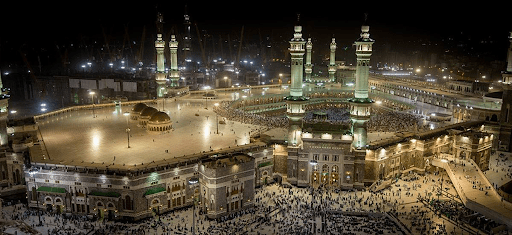
Masjid Al Haram, located in the heart of Makkah, is the most sacred mosque in Islam, serving as the spiritual center for Muslims worldwide. This revered sanctuary symbolizes unity, devotion, and unwavering faith, drawing millions of believers to its sacred grounds each year.
At the heart of Masjid Al Haram stands the Kaaba, an awe-inspiring black cube that serves as the focal point of prayer for Muslims across the globe. According to Islamic tradition, this sacred structure was originally built by Prophet Ibrahim (AS) and his son Ismail (AS) as a house of worship dedicated to the One Almighty. Its historical and religious significance make it the ultimate destination for Hajj and Umrah pilgrims, embodying the essence of faith, sacrifice, and divine connection.
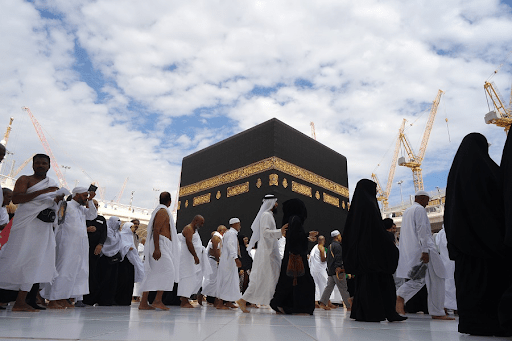
One of the most profound rituals performed at Masjid Al Haram is Tawaf, the act of circumambulating the Kaaba seven times in a counterclockwise direction. This sacred practice symbolizes devotion, humility, and the eternal connection between believers and their Creator.
During Tawaf, pilgrims may also have the opportunity to touch or kiss the Hajr-e-Aswad (Black Stone), embedded in one of the Kaaba’s corners. Revered in Islamic tradition, the Black Stone is believed to have been sent from heaven by the angel Jibreel (Gabriel). Touching or gazing upon it is considered a moment of deep spiritual significance, enhancing the pilgrimage experience and strengthening one’s faith.
Feature | Description | |
Hajr-e-Aswad (Black Stone) | A revered stone believed to have been sent from heaven, embedded in the Kaaba and kissed by pilgrims during Tawaf. | |
Zamzam Well | A blessed water source with divine origins, providing sustenance to pilgrims and symbolizing Allah’s mercy. | |
Safa and Marwah | Two hills signify the struggle and devotion of Hajra (AS) as she searched for water for her son, Prophet Ismail (AS); a key part of the Sa’i ritual. | |
Maqam-e-Ibrahim |
|
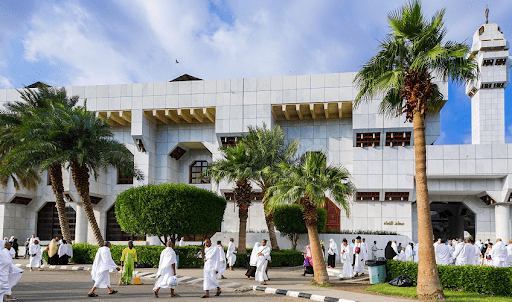
Masjid Aisha, the second-largest mosque in Makkah, holds profound religious significance for pilgrims embarking on their sacred journey. Situated along Muzdalifah Road, this revered mosque serves as a designated Miqat (boundary) where residents of Makkah and visitors intending to perform Umrah assume their Ihram.
For many, Masjid Aisha represents an essential step in their pilgrimage, reinforcing the spiritual connection to the traditions of Hajj and Umrah. The mosque’s serene ambiance and impressive architecture create a tranquil space for reflection and prayer.
“Masjid Aisha is the gateway to the pilgrimage, where pilgrims prepare themselves spiritually and physically for the rituals of Hajj and Umrah. It holds a special place in the hearts of Muslims who come here to seek blessings and embark on this transformative journey.” – Sheikh Abdullah, Imam of Masjid Aisha
Feature | Description |
Ihram Facility | Dedicated spaces for pilgrims to wear Ihram, marking the start of their Umrah journey. |
Renewing Ihram | Pilgrims can renew Ihram here after completing Tawaf at Masjid Al-Haram. |
Peaceful Atmosphere | A calm and spiritual environment that enhances the pilgrimage experience. |
Historical Importance | Holds deep ties to Hajj and Umrah rituals, making it a significant site for pilgrims. |
Unity in Faith | Welcomes Muslims from around the world, promoting unity and brotherhood. |
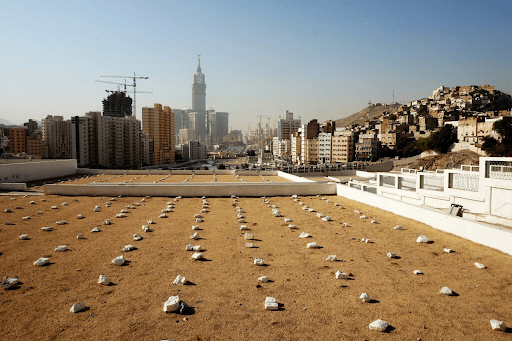
Nestled in the heart of Makkah, Jannat al-Mualla stands as one of the most revered cemeteries in Islamic history. This sacred burial ground is the final resting place of several esteemed figures from the early days of Islam, including the beloved family members of Prophet Muhammad (PBUH).
Among those interred here is Aminah, the Prophet’s mother, whose unwavering love and guidance played a pivotal role in shaping his early years. The cemetery also holds the graves of Khadija bint Khuwaylid, the Prophet’s first and most devoted wife, along with his son Qasim, his grandfather Abdul Muttalib, and his uncle Abu Talib, who steadfastly supported him throughout his mission.
Notable Individuals Buried at Jannat al-Mu’alla
Name | Relation to Prophet Muhammad ﷺ |
Aminah | Mother |
Khadija | First Wife |
Qasim | Son |
Abdul Muttalib | Grandfather |
Abu Talib | Uncle |
Jannat al-Mualla is more than a burial site—it is a testament to the profound legacy of those who played crucial roles in the development of Islam. Visiting this sacred site allows pilgrims and visitors to reflect on the sacrifices and dedication of these noble individuals, drawing inspiration from their unwavering faith.
The tranquil atmosphere of Jannat al-Mualla invites moments of deep contemplation and prayer, offering an opportunity to connect with the rich history of Islam. Here, amidst the silence, believers can honor the memory of the Prophet’s family and strengthen their spiritual connection to the past.
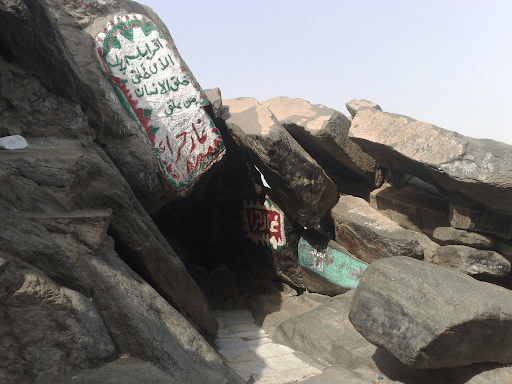
Perched high above Makkah, nestled within the rugged Jabal al-Noor (Mountain of Light), lies Ghar Hira, a site of profound spiritual and historical significance. It was here, in the solitude of this humble cave, that the course of history changed forever.
In the stillness of Ghar Hira, Angel Jibreel (AS) appeared before Prophet Muhammad (PBUH) and delivered the first divine revelation, commanding: “Read!” With this moment, the Quran’s revelation began, marking the dawn of Islam.
Feature | Description |
Location | On Jabal Al-Noor, 3 km from Masjid Al-Haram. |
Spiritual Significance | Site of first Quranic revelation to Prophet Muhammad ﷺ. |
Historical Importance | Marks the start of Prophethood and Islamic revelation. |
Climb Difficulty | Requires a 600-step steep climb, taking 45–60 minutes. |
Scenic View | Overlooks Makkah, including Masjid Al-Haram. |
Cave Size | Small, narrow space, fitting only a few people. |
Pilgrim Attraction | A significant Ziyarat site for visitors and pilgrims. |
The ascent to Ghar Hira is not for the faint-hearted. The climb is steep, the path challenging—but with every step, pilgrims draw closer to a moment that reshaped humanity. Guided by faith, they tread the same path once walked by the Prophet (PBUH), seeking a deeper connection to the origins of divine revelation.
Upon reaching the summit, the vast expanse of Makkah unfolds below. In the distance, the Kaaba stands as the heart of Islam, a symbol of unity and devotion.
Nestled within Jabal Thawr, Ghar Thawr stands as a powerful symbol of faith, trust, and divine protection in Islamic history. This sacred cave is where Prophet Muhammad (PBUH) and his closest companion, Abu Bakr (RA), sought refuge while escaping the relentless pursuit of the Quraysh during the Hijrah to Madinah.
As the Quraysh forces scoured the land in search of the Prophet (PBUH), divine intervention unfolded in the most unexpected manner. A spider wove its web across the cave’s entrance, and a dove nested nearby, creating an illusion that the cave had remained undisturbed for a long time. Deceived by this sight, the pursuers moved on, unaware that the Messenger of Allah (PBUH) was just within.
In that moment of uncertainty, Abu Bakr (RA) expressed his fear, to which the Prophet (PBUH) reassured him with words that continue to inspire believers today:
“Do not be sad; indeed, Allah is with us.” (Quran 9:40)
Feature | Description |
Location | Makkah, Saudi Arabia |
Significance | Refuge of Prophet Muhammad ﷺ and Abu Bakr (RA) during migration to Madinah |
Historical Importance | Symbol of the challenges and sacrifices made for Islam |
Spiritual Reflection | A place to reflect on the Prophet’s resilience and trust in Allah |
Makkah is home to several sacred sites beyond the well-known Ziyarat locations. Jabal-e-Rehmat marks the reunion of Prophet Adam (AS) and Hawwa (AS) and the site of the Prophet’s (PBUH) Farewell Sermon. Masjid Nimrah stands as a reminder of the Day of Arafah, while Muzdalifah is where pilgrims spend the night under the open sky, gathering pebbles for Rami (stoning of the devil) in Mina, the “City of Tents.” Here, pilgrims also perform Qurbani (sacrifice) in honor of Prophet Ibrahim (AS). Other notable sites include Bir Tuwa, a blessed well, and Masjid al-Khayf, where many prophets prayed. Each place carries deep historical and spiritual significance, enriching the journey of every pilgrim.
Makkah is not just a city—it is the heart of Islamic heritage, faith, and devotion. Each sacred site within its boundaries tells a story of sacrifice, revelation, and divine guidance. From the sanctity of Masjid Al Haram and the Kaaba to the historical caves of Hira and Thawr, every landmark strengthens the spiritual connection of believers to the foundations of Islam.
The resting places of the Prophet’s family in Jannat al-Mualla, the significance of Masjid Aisha, and the historic plains of Mina, Arafah, and Muzdalifah serve as reminders of unwavering faith and devotion. Visiting these Ziyarat sites is more than a journey—it is a transformative experience that deepens one’s understanding of Islamic history and strengthens the bond with Allah. For every pilgrim, Makkah remains a place of enlightenment, reflection, and eternal spiritual fulfillment.